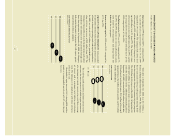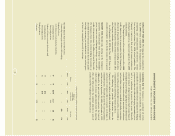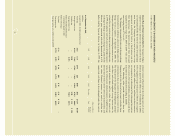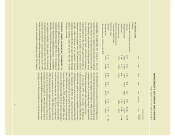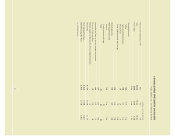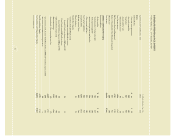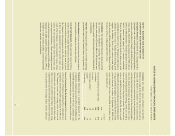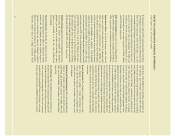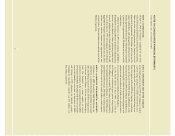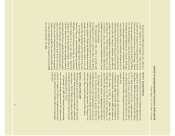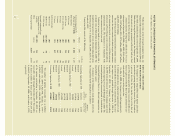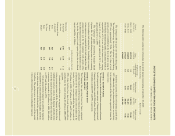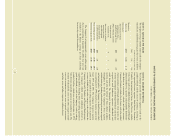Tyson Foods 2000 Annual Report Download - page 36
Download and view the complete annual report
Please find page 36 of the 2000 Tyson Foods annual report below. You can navigate through the pages in the report by either clicking on the pages listed below, or by using the keyword search tool below to find specific information within the annual report.
NOTES TO CONSOLIDATED FINANCIAL STATEMENTS
TYSON FOODS, INC. 2000 ANNUAL REPORT
If impairment is indicated by using undiscounted cash flows,
the Company measures impairment using discounted cash
flows of future operating results based upon a rate that
corresponds to the Company’s cost of capital. Impairments
are recognized in operating results to the extent that carry-
ing value exceeds fair value. At September 30, 2000, and
October 2, 1999, the accumulated amortization of excess
of investments over net assets acquired was $256 million
and $225 million, respectively.
Other Current Liabilities: Insurance reserves totaling $102 mil-
lion and $95 million at September 30, 2000, and October 2,
1999, respectively, are included in other current liabilities.
Capital Stock: Holders of Class B common stock (Class B
stock) may convert such stock into Class A common stock
(Class A stock) on a share-for-share basis. Holders of
Class B stock are entitled to 10 votes per share while holders
of Class A stock are entitled to one vote per share on matters
submitted to shareholders for approval. Cash dividends
cannot be paid to holders of Class B stock unless they are
simultaneously paid to holders of Class A stock. The per
share amount of the cash dividend paid to holders of Class B
stock cannot exceed 90% of the cash dividend simultaneously
paid to holders of Class A stock. The Company pays quar-
terly cash dividends to Class A and Class B shareholders.
The Company paid Class A dividends per share of $0.16,
$0.115 and $0.10 and Class B dividends per share of $0.144,
$0.104 and $0.09 in 2000, 1999 and 1998, respectively.
Stock-Based Compensation: Stock-based compensation is recog-
nized using the intrinsic value method. For disclosure
purposes, pro forma net income and earnings per share
impacts are provided as if the fair value method had
been applied.
Financial Instruments: Periodically, the Company uses deriva-
tive financial instruments to reduce its exposure to various
market risks. The Company does not regularly engage in
speculative transactions, nor does the Company regularly
hold or issue financial instruments for trading purposes.
Generally, contract terms of a hedge instrument closely
mirror those of the hedged item providing a high degree of
risk reduction and correlation. Contracts that effectively
meet the risk reduction and correlation criteria are recorded
using hedge accounting. Financial instruments that do not
meet the criteria for hedge accounting are marked to fair
value with gains or losses reported currently in earnings.
Interest rate swaps are used to hedge exposure to changes
in interest rates under various leveraged equipment loans.
Settlements of interest rate swaps are accounted for as an
adjustment to interest expense. Commodity futures and options
are used to hedge a portion of the Company’s purchases
of certain commodities for future processing requirements.
Such contracts are accounted for as hedges, with gains and
losses recognized as part of cost of sales, and generally have
terms of less than 15 months. Foreign currency forwards and
option contracts are used to hedge sale and debt transactions
denominated in foreign currencies to reduce the currency risk
associated with fluctuating exchange rates. Such contracts
generally have terms of less than 12 months. Unrealized gains
and losses are deferred as part of the basis of the underlying
transaction.
Revenue Recognition: The Company recognizes sales revenue
upon shipment of product. Certain international sales
revenue and live swine sales revenue are recognized after
transfer of title or delivery of product, which may occur
after shipment.
Advertising and Promotion Expenses: Advertising and promotion
expenses are charged to operations in the period incurred.
Advertising and promotion expenses for 2000, 1999 and
1998 were $280 million, $301 million and $294 million,
respectively.
Use of Estimates: The consolidated financial statements are
prepared in conformity with accounting principles generally
accepted in the United States which require management to
make estimates and assumptions that affect the amounts
reported in the consolidated financial statements and accom-
panying notes. Actual results could differ from those estimates.
34


